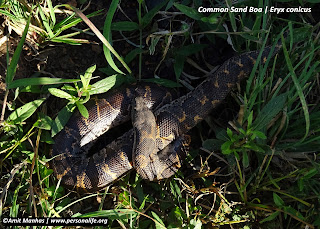Eryx conicus, ommon sand boa
Eryx conicus is commonly known as common sand boa or rough-scaled sand boa, and is a species of family boidae having small head with thick robust body and having irregular dorsal patches on the body with a short tail with very rough scales and pointed at tip. The species looks like to species "Python molurus" and somewhat to Russell''s viper but is a non- venomous species of snakes. It is a small to medium sized species of snake.

It is found in India (Jammu & Kashmir, Kerala, Himachal Pradesh, Uttar Pradesh, Madhya Pradesh, Karnataka, Andhra Pradesh, Maharashtra, Tamil Nadu, Punjab & Gujarat), Nepal, Bangladesh, Pakistan & Sri-Lanka.
Scientific classification
Kingdom: Animalia
Phylum: Chordata
Class: Reptilia
Order: Squamata
Suborder: Serpentes
Family: Boidae
Genus: Eryx
Species: conicus
Binomial name
Eryx conicus Schneider, 1801
The head of the species is not well distinct from the neck & are covered with small keeled scales. The eyes are small having vertical pupil. The dorsal scales of the species are small and highly keeled. While the tail in these snakes is short, thick having very high keeled scales which look dry in appearance & is pointed towards tip. On the dorsal side there is a colored pattern of broad zigzag shaped bands having a series of dark brown blots while the belly is unvarying white with narrow scales. Sub caudal scales are not paired. Snakes of this species can attain maximum size of 3 ft. 3 inches, including 3 inches of tail. The species is mostly active at night (nocturnal) but can be seen during day sometimes. The species feed mostly on worms, birds, geckos, small rodents & mammals.

Variation in various characteristics of Eryx conicus sighted
Measurements
Full body length :1.31 ft. -1.96 ft.
Snout-vent length :1.1 ft.-1.70 ft.
Tail length :0.19-0.26
Scalation
**Dorsal scales (A:M:P):37:47:27
Supra-labial scales :12/12-13/13
Infra-labial scales:12/12-14/14
Ventral scales;158-170
Anal scales :3-4
Sub caudal scales :17-24
**Note: A- Anterior; M-Midbody; P-Posterior
It has inhabited variety of habitats ranging from gardens to agricultural lands, cracks to rat holes. In rock crevices to sandy soil, mounds, brick piles to rock piles. Though, this species spend most of its time as a burrower. Locomotion in these snakes is very slow & lethargic. It is usually a non-offensive species of snake and mostly tries to escape when encountered & makes a coil and hide its head in between in defense but can bite when are in aggressive mood when they flattens its whole body to strike. Anthropogenic pressures are the main threat of the species throughout its distribution. It is ovoviviparous species & gives birth to 6-8 juveniles during May to June mostly.
Literature cited:
Boulenger, G.A. 1890. The fauna of British India including Ceylon and Burma, Reptilia and Batrachia. Taylor and Francis, London.
http://indian-animals.blogspot.com/2009/05/eryx-conicus.html
http://reptile-database.reptarium.cz/species?genus=Eryx&species=conicus
http://www.indiansnakes.org/content/common-sand-boa
https://en.wikipedia.org/wiki/Gongylophis_conicus
Manhas, A., Kotwal, A., Wanganeo, R.R. and Wanganeo, A., 2015. Diversity, Threats and Conservation of Herpetofauna in and around Barkatullah University, Bhopal (MP), India. Int. J. Adv. Res. 3: 1546-1553.
Manhas, A., Raina, R. and Wanganeo, A. 2017. Current Status and Diversity of Ophidians (Reptilia: Squamata: Serpents) in Bhopal, Madhya Pradesh, Central India. Int. J. Cur. Micro. Appl. sci., 6 (5): 1384-1390.
Manhas, A., Raina, R. and Wanganeo, A. 2018. Reptilian diversity of the Bhopal region of state Madhya Pradesh of central India. IRCF Reptiles & Amphibians, 25 (2):104-114.
Manhas, A., Raina, R., and Wanganeo, A. 2016. An addition to the reptilian diversity of Barkatullah university campus, Bhopal, Madhya Pradesh, India. Int. J. Pure Appl. Zool., 4 (4): 306-309.
Manhas, A., Raina, R., and Wanganeo, A., 2015. Snakes of the Bhopal district, Madhya Pradesh, India with special reference to road mortality. J. Res. Biol., 5: 1868-1873.
Manhas, A., Raina, R., and Wanganeo, A., 2016. An assessment of reptilian diversity and their distribution in Jammu and Kashmir state from Jammu city in northern India: A case study. IJFBS 3: 20-23.
Smith, M.A. 1943. The fauna of British India, Ceylon and Burma including the whole of the Indo-Chinese sub-region, Reptilia and Amphibia. Vol. III, Serpentes, Taylor & Francis, London.















COMMENTS